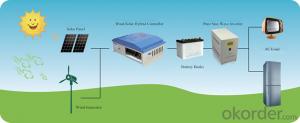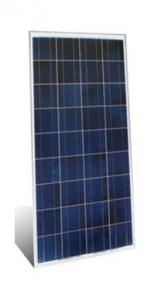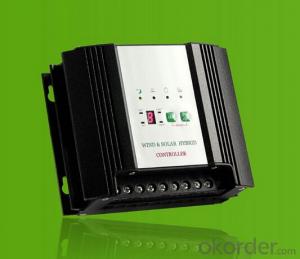Controller 5KW Wind Solar Hybrid PWM Stepless Unload Mode
- Loading Port:
- Shanghai
- Payment Terms:
- TT or LC
- Min Order Qty:
- 1 unit
- Supply Capability:
- 5000 unit/month
OKorder Service Pledge
OKorder Financial Service
You Might Also Like
I. PRODUCT INTRODUCTION
The wind/solar hybrid controller is control device which can control wind turbine and solar panel at the same time and transform wind and solar energy into electricity then store to the battery bank. Wind/solar hybrid controller is the most important part in off-grid system, whose performance has much effect on life expectancy and operational stability of the whole system, especially the battery expectancy. Or battery service life will be shortened by over-charge or over-discharge.
II. PERFORMANCE FEATURES
Superior military-grade components to ensure the product stability.
Perfect protection function, thus the system has higher reliability.
Check and set all operation parameters as requirement from LCD display.
Voltage limiting and current-limiting charge mode ensures battery in the best charging status.
PWM stepless unload mode, which burn the excess power into dump load, making the battery charging in best status.
III. APPLICATION AREAS
Stand alone wind/solar hybrid power station; Stand alone domestic household wind/solar hybrid power system.
Mobile communication base stations, expressway and other non-residential regions.
Coastal islands, remote mountainous, border posts for regions shortage of or without electricity.
Government demonstration projects, landscape lighting project.
IV. 5KW TECHNICAL PARAMETERS
Product Model | WWS50-48 | WWS50-96 | WWS50-120 | WWS50-220 | WWS50-240 |
Rated Battery Voltage | 48V | 96V | 120V | 220V | 240 |
Rated Wind Turbine Input Power | 5kW | 5kW | 5kW | 5kW | 5kW |
Maximum Wind Turbine Input Power | 7.5kW | 7.5kW | 7.5kW | 7.5kW | 7.5kW |
Wind Turbine Brake Current | 105A | 52A | 42A | 23A | 21A |
Rated Solar Input Power | 1.5kW | 1.5kW | 1.5kW | 1.5kW | 1.5kW |
Floating Charging Voltage | 58V | 116V | 145V | 266V | 290V |
Dimension (L x W x H) | Control Box:440×305×170 mm, Dumpload Box:770×390×180 mm | ||||
Net Weight | Control Box:7.5 kg, Dumpload Box:17 kg | ||||
Display Mode | LCD | ||||
Cooling | Fan | ||||
Protection Level | IP20(Indoor) | ||||
Quiescent Current | ≤20 mA | ||||
Protection Functions | Battery over charge; Battery over discharge; solar reverse charge protection; anti-reverse-connection protection; wind turbine over rotate speed protection; wind turbine over wind speed protection; wind turbine over voltage protection; wind turbine over current protection; manual brake protection; automatically brake protection; lightning protection. | ||||
Ambient temperature | -20~+55℃ | ||||
Ambient Humidity | 0~93%, without condensing | ||||
Working Altitude | ≤4000m | ||||
In order to serve our customers better. Our company can adjust parameters configuration according to customer’s requirement. | |||||

- Q:Can a solar controller be used with solar panel cooling systems?
- Solar panel cooling systems can indeed utilize a solar controller. The solar controller's role encompasses the regulation of power flow from the solar panels to either the batteries or grid. Additionally, it monitors and safeguards the batteries against overcharging or discharging. In the context of solar panel cooling systems, the solar controller can be employed to energize and manage the cooling mechanism. This guarantees that the solar panels maintain ideal temperatures, thereby enhancing their efficiency and lifespan. By employing a solar controller, the cooling system can operate with maximum effectiveness and efficiency, thus optimizing the solar panels' productivity.
- Q:Can a solar controller be used with solar-powered remote monitoring systems?
- Yes, a solar controller can be used with solar-powered remote monitoring systems. A solar controller regulates the electrical charge from solar panels and ensures the batteries are charged efficiently. This is crucial for remote monitoring systems as it helps maintain a steady power supply and prolongs the battery life, enabling continuous and reliable operation.
- Q:How do I calculate the required battery capacity for a solar controller?
- In order to determine the appropriate battery size for a solar controller, there are several key factors that need to be taken into consideration. Here is a step-by-step guide to help you calculate the required battery capacity: 1. Start by calculating the total energy consumption of the devices or systems that will be powered by the solar controller. This can be done by identifying the power consumption (measured in watts) and the daily usage (measured in hours) of each device. 2. It is important to account for energy losses that occur during the conversion and storage process. Consider the efficiency ratings of the solar panels, charge controller, and battery. It is recommended to include a buffer of 10-20% to compensate for these losses. 3. Multiply the power consumption of each device by the daily usage to calculate the daily energy requirement for each device. Add up these values to find the total daily energy requirement. 4. Determine how many days you want your system to operate without sunlight. Multiply the daily energy requirement by the number of days of autonomy to calculate the total energy storage needed. 5. Take into account the efficiency rating of the battery, which is typically around 80-90%. Divide the total energy storage needed by the battery efficiency to determine the required battery capacity. 6. It is crucial to consider the maximum depth of discharge (DoD) that is acceptable for your battery type. Avoid completely discharging the batteries as it can reduce their lifespan. Multiply the required battery capacity by the reciprocal of the DoD (e.g., 50%) to get the minimum recommended battery capacity. 7. To ensure optimal performance and accommodate any unforeseen factors, it is advisable to add a safety margin of 10-20% to the calculated battery capacity. By following these steps and considering the various factors involved, you can accurately calculate the required battery capacity for your solar controller. Remember to consult the manufacturer's specifications and recommendations for your specific solar controller and battery type to ensure precise calculations.
- Q:What is the cost of a solar controller?
- The cost of a solar controller can vary depending on several factors such as brand, capacity, features, and quality. On average, a basic solar controller can range from $20 to $50, while more advanced models with additional functionalities can cost anywhere from $50 to $200 or more.
- Q:How does a solar controller prevent short circuits in the solar panel system?
- A solar controller, also known as a charge controller, plays a crucial role in preventing short circuits in a solar panel system. It acts as a middleman between the solar panels and the battery or load, ensuring that the flow of electricity is regulated and controlled. One of the main functions of a solar controller is to regulate the charging process of the battery. It monitors the voltage and current levels from the solar panels and ensures that the battery is charged within safe limits. By carefully managing the charging process, it prevents any excessive flow of electricity that could potentially cause a short circuit. Additionally, a solar controller incorporates various protective features to prevent short circuits. It typically includes circuit breakers or fuses that act as safeguards in case of any electrical faults. These protective devices are designed to interrupt the flow of electricity in case of an overcurrent situation, preventing any damage or short circuit in the system. Furthermore, solar controllers often have built-in mechanisms to protect against reverse current flow. During the night or in low light conditions when the solar panels are not generating power, the controller ensures that the battery's current does not flow back into the panels, which could cause a short circuit. By preventing reverse current flow, the controller safeguards the system from potential electrical faults. Overall, a solar controller plays a vital role in preventing short circuits in a solar panel system by regulating the charging process, incorporating protective features like circuit breakers or fuses, and preventing reverse current flow. Its primary objective is to maintain a safe and efficient flow of electricity, ensuring the longevity and reliability of the entire solar panel system.
- Q:Can a solar controller be used with a solar-powered security camera system?
- Yes, a solar controller can be used with a solar-powered security camera system. A solar controller helps regulate and optimize the charging of batteries connected to solar panels, ensuring efficient power management for the camera system.
- Q:What is the role of a battery low voltage disconnect function in a solar controller?
- The role of a battery low voltage disconnect function in a solar controller is to protect the battery from being over-discharged. It automatically cuts off the power supply from the solar panels to the battery when the battery voltage drops below a certain threshold. This helps extend the battery's lifespan and ensures that there is always enough charge left for essential loads.
- Q:How does a solar controller handle variations in solar panel soiling?
- A solar controller does not directly handle variations in solar panel soiling. Its primary function is to regulate the charge and discharge of the battery connected to the solar panel system. However, it indirectly helps mitigate the effects of soiling by optimizing the performance of the solar panels. By monitoring the voltage and current produced by the panels, the controller ensures that the maximum power point tracking (MPPT) algorithm is employed, which adjusts the panel's operating conditions to extract the most power possible. This helps compensate for any losses caused by soiling and maintain the overall efficiency of the solar panel system.
- Q:Can a solar controller be used with solar panel carports?
- Yes, a solar controller can be used with solar panel carports. A solar controller is an essential component of a solar power system as it regulates the voltage and current from the solar panels to ensure efficient charging of batteries or powering of electrical loads. In the case of solar panel carports, a solar controller would be necessary to manage the energy production and distribution, maximizing the utilization of solar power and ensuring the longevity of the batteries used to store excess energy.
- Q:Can a solar controller be used with solar-powered outdoor recreational equipment?
- Yes, a solar controller can be used with solar-powered outdoor recreational equipment. The solar controller helps regulate the charging and discharging of the batteries in the equipment, ensuring optimal performance and preventing overcharging or damage to the batteries.
1. Manufacturer Overview |
|
|---|---|
| Location | |
| Year Established | |
| Annual Output Value | |
| Main Markets | |
| Company Certifications | |
2. Manufacturer Certificates |
|
|---|---|
| a) Certification Name | |
| Range | |
| Reference | |
| Validity Period | |
3. Manufacturer Capability |
|
|---|---|
| a)Trade Capacity | |
| Nearest Port | |
| Export Percentage | |
| No.of Employees in Trade Department | |
| Language Spoken: | |
| b)Factory Information | |
| Factory Size: | |
| No. of Production Lines | |
| Contract Manufacturing | |
| Product Price Range | |
Send your message to us
Controller 5KW Wind Solar Hybrid PWM Stepless Unload Mode
- Loading Port:
- Shanghai
- Payment Terms:
- TT or LC
- Min Order Qty:
- 1 unit
- Supply Capability:
- 5000 unit/month
OKorder Service Pledge
OKorder Financial Service
Similar products
New products
Hot products
Hot Searches
Related keywords





























